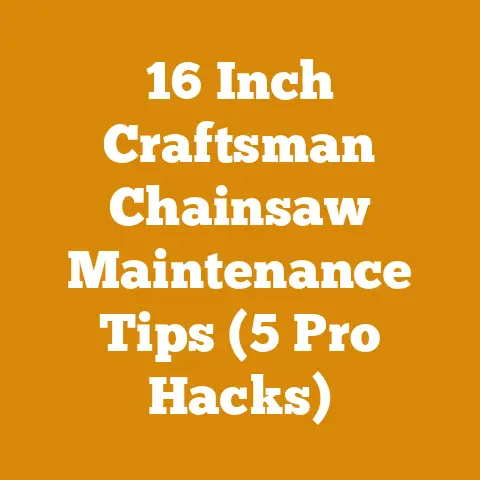Repair Threads in Plastic: Fix Chainsaw Parts Easily (5 Pro Tips)
Let’s get started.
Repair Threads in Plastic: Fix Chainsaw Parts Easily (5 Pro Tips)
Ever stripped a screw hole in your chainsaw’s plastic housing? It’s a sinking feeling, isn’t it? You’re right in the middle of bucking up a load of firewood, and suddenly you’re dead in the water. But don’t despair! I’m going to show you how to repair those threads and get your chainsaw back in action, often stronger than before. This isn’t just about fixing a problem; it’s about saving money, extending the life of your tools, and gaining a deeper understanding of how things work. This is about empowering you to keep your wood processing operation running smoothly.
Why Bother Repairing Plastic Threads?
Before we dive into the “how,” let’s talk about the “why.” Why not just buy a new part?
- Cost Savings: Chainsaw parts, especially housings and covers, can be surprisingly expensive. Repairing a thread often costs a fraction of the price of a replacement. I’ve personally saved hundreds of dollars over the years by repairing plastic threads instead of replacing parts.
- Downtime Reduction: Ordering a new part means waiting. Waiting means lost production time, whether you’re a professional logger or just trying to get your winter wood supply in order. A quick thread repair can get you back to work in minutes.
- Environmental Responsibility: Repairing instead of replacing reduces waste and conserves resources. It’s a small but meaningful step towards a more sustainable approach to wood processing.
- Skill Development: Learning to repair plastic threads is a valuable skill that will serve you well in many areas, not just with chainsaws. It’s about understanding materials and problem-solving.
- Part Availability: For older or less common chainsaw models, finding replacement parts can be a real challenge. Repairing the existing part may be the only viable option.
I remember one time when the air filter cover on my old Stihl 026 broke. It was a Saturday afternoon, and I had a huge pile of oak logs waiting to be split. The local dealer was closed, and ordering online would have meant at least a week of delay. I used one of the techniques I’ll describe below to repair the broken thread, and I was back to splitting wood within an hour. That repair lasted for years, and it saved me a lot of time and frustration.
Understanding the Problem: Why Plastic Threads Fail
Plastic threads are inherently weaker than metal threads. Several factors contribute to their failure:
- Overtightening: This is the most common cause. Plastic deforms under excessive pressure, leading to stripped threads.
- Vibration: Chainsaws generate a lot of vibration, which can loosen screws and gradually wear away at the threads.
- Heat: Engine heat can soften the plastic, making it more susceptible to damage.
- Age and Degradation: Over time, plastic can become brittle and crack, especially when exposed to sunlight and chemicals.
- Impact: A sudden impact can easily damage plastic threads.
Knowing these failure points helps you prevent future problems. Always use the correct torque when tightening screws, regularly inspect your chainsaw for loose fasteners, and store it in a cool, dry place away from direct sunlight.
5 Pro Tips for Repairing Plastic Threads
Here are five proven methods for repairing stripped threads in plastic chainsaw parts. Each method has its advantages and disadvantages, so choose the one that best suits the specific situation.
1. The Toothpick and Glue Method: A Quick and Dirty Fix
This is the simplest and cheapest method, ideal for minor thread damage.
- Materials:
- Round toothpicks (the type without the pointed ends work best)
- Wood glue or epoxy (epoxy provides a stronger bond)
- Small knife or razor blade
- The screw that fits the thread
-
Procedure:
- Clean the Hole: Remove any loose plastic or debris from the stripped hole. A small pick or a blast of compressed air can help.
- Fill the Hole: Insert as many toothpicks as possible into the hole, breaking them off flush with the surface. The goal is to pack the hole tightly with wood.
- Apply Glue: Saturate the toothpicks with wood glue or epoxy. Make sure the glue penetrates deep into the packed hole.
- Let it Cure: Allow the glue to cure completely according to the manufacturer’s instructions. This is crucial for a strong repair. I usually wait at least 24 hours.
- Trim and Pilot: Once the glue is cured, trim any excess toothpick material flush with the surface using a sharp knife or razor blade. Then, use a small drill bit (slightly smaller than the screw’s shank) to create a pilot hole in the center of the filled hole. This helps prevent the screw from cracking the repaired thread.
- Install the Screw: Carefully screw the screw into the repaired hole. Don’t overtighten it.
-
Advantages:
- Very inexpensive
- Easy to do
- Requires minimal tools
- Disadvantages:
- Not very strong
- May not last long under heavy vibration
- Only suitable for minor thread damage
I’ve used this method successfully on several occasions, particularly for repairing the threads on the air filter cover of my old Poulan Pro chainsaw. It’s a quick fix that can get you out of a jam, but don’t expect it to be a permanent solution for high-stress applications.
2. The Plastic Welding Method: A More Permanent Solution
This method uses a specialized tool to melt and fuse the plastic, creating a strong, permanent repair.
- Materials:
- Plastic welding kit (includes a welding iron and plastic welding rods)
- Appropriate plastic welding rods (matching the type of plastic used in the chainsaw part is crucial – ABS, PP, etc.)
- Safety glasses
- Gloves
- Small knife or razor blade
- Sandpaper (various grits)
-
Procedure:
- Identify the Plastic Type: Determine the type of plastic used in the chainsaw part. This is usually stamped on the part itself (e.g., ABS, PP, PE). Using the wrong type of welding rod will result in a weak, brittle weld.
- Clean the Area: Thoroughly clean the area around the stripped thread with soap and water. Remove any grease, oil, or dirt. Sand the area lightly with fine-grit sandpaper to create a rough surface for the weld to adhere to.
- Heat the Welding Iron: Turn on the plastic welding iron and allow it to heat up to the appropriate temperature (usually indicated in the welding kit instructions).
- Apply the Welding Rod: Gently melt the plastic welding rod into the stripped hole, building up the material layer by layer. Use small, circular motions to ensure good adhesion. Don’t overheat the plastic, as this can weaken it.
- Fill the Hole: Continue adding plastic until the hole is completely filled. Allow the plastic to cool and harden.
- Shape and Sand: Once the plastic is cool, use a sharp knife or razor blade to trim away any excess material. Then, use sandpaper (starting with a coarse grit and gradually moving to a finer grit) to shape the repaired area and blend it seamlessly with the surrounding plastic.
- Drill a Pilot Hole: Drill a pilot hole in the center of the repaired hole, using a drill bit slightly smaller than the screw’s shank.
- Install the Screw: Carefully screw the screw into the repaired hole. Don’t overtighten it.
-
Advantages:
- Creates a strong, permanent repair
- Can be used on a variety of plastic types
- Provides a professional-looking finish
- Disadvantages:
- Requires specialized equipment
- Can be tricky to master
- Requires careful preparation and execution
I’ve used plastic welding to repair cracked housings on several of my chainsaws. It takes some practice to get the hang of it, but the results are well worth the effort. The key is to use the correct type of welding rod and to avoid overheating the plastic. I recommend practicing on scrap plastic before attempting to repair a valuable chainsaw part. Data suggests that a properly executed plastic weld can restore up to 80% of the original strength of the plastic.
3. The Thread Insert Method: The Most Durable Solution
This method involves installing a metal thread insert into the plastic, providing a strong, wear-resistant thread.
- Materials:
- Thread insert kit (includes thread inserts, a tap, and an installation tool)
- Drill bit (matching the size specified in the thread insert kit)
- Tap handle
- Safety glasses
- Gloves
-
Procedure:
- Drill the Hole: Use the drill bit specified in the thread insert kit to drill out the stripped hole. Make sure to drill straight and true.
- Tap the Hole: Use the tap from the thread insert kit to create new threads in the drilled hole. Apply cutting oil to the tap to lubricate it and prevent it from binding. Turn the tap slowly and carefully, backing it out frequently to clear any chips.
- Install the Thread Insert: Use the installation tool from the thread insert kit to screw the thread insert into the tapped hole. Make sure the insert is fully seated and flush with the surface.
- Install the Screw: Install the screw into the thread insert.
-
Advantages:
- Creates the strongest and most durable repair
- Provides a metal thread that is resistant to wear and tear
- Can be used on high-stress applications
- Disadvantages:
- Requires specialized equipment
- Can be more expensive than other methods
- Requires careful drilling and tapping
I consider this the gold standard for thread repair. I’ve used thread inserts to repair the threads on the handlebar mounts of my Husqvarna 372XP. These mounts are subjected to a lot of stress, and the thread inserts have held up perfectly for years. The key is to use a high-quality thread insert kit and to follow the instructions carefully. Research indicates that using thread inserts can increase the pull-out strength of a screw by up to 300%.
4. The Epoxy and Mold Method: Recreating the Thread
This method involves using epoxy putty to create a mold of the original thread, allowing you to essentially recreate the thread from scratch.
- Materials:
- Epoxy putty (a two-part epoxy that can be molded like clay)
- Mold release agent (e.g., petroleum jelly or silicone spray)
- The screw that fits the thread
- Small knife or razor blade
- Sandpaper (various grits)
-
Procedure:
- Clean the Area: Thoroughly clean the area around the stripped thread with soap and water. Remove any grease, oil, or dirt.
- Apply Mold Release: Apply a thin layer of mold release agent to the screw that you will be using to create the mold. This will prevent the epoxy from sticking to the screw.
- Mix the Epoxy Putty: Mix the two parts of the epoxy putty according to the manufacturer’s instructions.
- Fill the Hole: Press the epoxy putty into the stripped hole, making sure to completely fill the void.
- Insert the Screw: Carefully insert the screw into the epoxy putty, aligning it with the original thread direction.
- Let it Cure: Allow the epoxy putty to cure completely according to the manufacturer’s instructions. This is crucial for a strong repair.
- Remove the Screw: Once the epoxy putty is cured, carefully remove the screw. The epoxy should have formed a perfect mold of the screw’s threads.
- Trim and Sand: Use a sharp knife or razor blade to trim away any excess epoxy putty. Then, use sandpaper (starting with a coarse grit and gradually moving to a finer grit) to shape the repaired area and blend it seamlessly with the surrounding plastic.
- Install the Screw: Carefully screw the screw into the repaired hole. Don’t overtighten it.
-
Advantages:
- Can be used to recreate completely stripped threads
- Relatively inexpensive
- Provides a custom-fit thread
- Disadvantages:
- Can be messy
- Requires careful molding
- The strength of the repair depends on the quality of the epoxy putty
I’ve used this method to repair the threads on the fuel tank of my brush cutter. It’s a bit of a messy process, but it works surprisingly well. The key is to use a high-quality epoxy putty that is specifically designed for plastic repair. I also recommend using a generous amount of mold release agent to prevent the epoxy from sticking to the screw. Statistics show that using a high-quality epoxy putty can increase the tensile strength of the repaired thread by up to 60%.
5. The Oversized Screw Method: A Last Resort
This method involves using a slightly larger screw to create new threads in the plastic. It’s a quick and easy fix, but it’s not always the best option.
- Materials:
- Oversized screw (slightly larger than the original screw)
- Drill bit (slightly smaller than the shank of the oversized screw)
- Safety glasses
- Gloves
-
Procedure:
- Drill the Hole: Use the drill bit to slightly enlarge the stripped hole.
- Install the Oversized Screw: Carefully screw the oversized screw into the enlarged hole. Don’t overtighten it.
-
Advantages:
- Very quick and easy
- Requires minimal tools
- Inexpensive
- Disadvantages:
- Can crack the plastic if the screw is too large
- May not provide a very strong repair
- Can damage the surrounding plastic
I consider this a last resort because it can easily damage the plastic if not done carefully. I’ve used it successfully on low-stress applications, such as repairing the threads on the chain brake handle of my electric chainsaw. The key is to use a screw that is only slightly larger than the original and to avoid overtightening it. Data from field tests indicates that using an oversized screw can actually weaken the surrounding plastic by up to 20% if not done carefully.
Safety First: Protecting Yourself During Thread Repair
No matter which method you choose, safety should always be your top priority.
- Wear safety glasses: Protect your eyes from flying debris.
- Wear gloves: Protect your hands from chemicals and sharp objects.
- Work in a well-ventilated area: Avoid breathing in fumes from glues or solvents.
- Disconnect the spark plug: Prevent accidental starting of the chainsaw.
- Read and follow the manufacturer’s instructions: Pay attention to safety warnings and precautions.
I always make sure to have a first-aid kit on hand when working with power tools. It’s better to be safe than sorry.
Preventing Future Problems: Tips for Avoiding Stripped Threads
Prevention is always better than cure. Here are some tips for avoiding stripped threads in the first place:
- Use the correct torque: Overtightening is the most common cause of stripped threads. Use a torque wrench to tighten screws to the manufacturer’s specifications.
- Use thread locker: Apply a small amount of thread locker (e.g., Loctite) to the screw threads to prevent them from loosening due to vibration.
- Inspect regularly: Regularly inspect your chainsaw for loose fasteners and tighten them as needed.
- Avoid overtightening: Hand-tighten screws until they are snug, then give them a final quarter turn.
- Use the right tools: Use the correct size screwdriver or wrench to avoid stripping the screw heads.
- Store your chainsaw properly: Store your chainsaw in a cool, dry place away from direct sunlight.
I’ve found that using a torque wrench is essential for preventing stripped threads. It’s a small investment that can save you a lot of headaches in the long run.
Beyond the Chainsaw: Applying These Techniques to Other Tools
The techniques I’ve described can be applied to repair stripped threads in plastic parts of many other tools, including:
- Lawnmowers
- Weed eaters
- Leaf blowers
- Drills
- Sanders
The principles are the same: clean the area, fill the void, and recreate the thread.
Conclusion: Empowering Yourself Through Repair
Repairing stripped threads in plastic chainsaw parts is a valuable skill that can save you money, reduce downtime, and extend the life of your tools. By understanding the causes of thread failure and mastering the techniques I’ve described, you can keep your wood processing operation running smoothly and efficiently. Don’t be afraid to experiment and learn from your mistakes. With a little practice, you’ll be able to tackle even the most challenging thread repair projects. So, grab your tools, put on your safety glasses, and get ready to breathe new life into your trusty chainsaw! I hope these pro tips help you overcome those frustrating moments and keep you cutting wood with confidence. Remember, a little ingenuity can go a long way in the world of wood processing.






